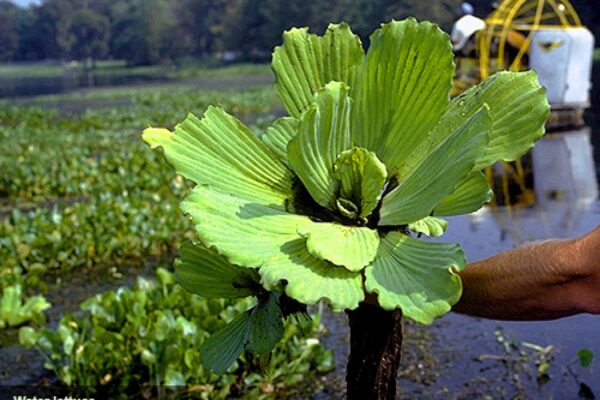Water Lettuce

Species at a Glance
Water lettuce (Pistia stratiotes) is a floating perennial plant that resembles an open head of lettuce. It forms in colonies of rosettes that link together to blanket the water’s surface, blocking waterways and disrupting natural ecosystems.
Identification
Water lettuce has thick, soft, light green leaves that are formed in rosettes with no leaf stems. Rosettes can occur by themselves or connected to others by short stolons. Leaves are large, up to 16 cm (6 in) long with parallel ridges (veins) covered in short hairs, and margins are wavy, and the top margins are scalloped.
The flowers are inconspicuous and hidden in clusters amongst the leaves in the center of the plant. They form on a small stalk with a single female flower and a whorl of male flowers above. The fruit arises from the female flower and develops many-seeded green berries. The roots are light-colored and feathery, and hang submerged beneath the floating leaves.
Similar Species
Water lettuce may be confused with water hyacinth (Eichhornia crassipes); however, water lettuce has large, ribbed leaves and it doesn’t have the showy flowers characteristic of water hyacinth.
Habitat
Mostly occurring in slightly acidic lakes, rivers, ponds, and canals in temperate climates, water lettuce has also been found to survive in mud. It is not winter hardy, requiring temperatures above 15°C (59°F) for growth.
Spread
While some believe water lettuce is native to the United States, others believe it was brought over in the ballast water of ships from the tropical and subtropical regions of Asia, Africa, and South America. It is also commonly sold through the aquarium industry and additional introductions have occurred as plants are intentionally released or escape from ponds and water gardens. This plant can spread by fragmentation, by daughter plants that form on the stolons of the mother plant, or by seeds.
Distribution
Water lettuce has been present in Florida since as early as 1765; however, it has since spread throughout the southeastern United States north to New York and westward to Texas, Arizona, and California. It is also present in Hawaii. In the Mid-Atlantic, water lettuce is found in Delaware, New Jersey, New York, North Carolina, and Maryland. In Pennsylvania, Water Lettuce is found in Erie, Northampton, and Chester Counties.
Environmental Impacts
The large mats formed by water lettuce negatively impact boating, fishing, and swimming. They also make navigation difficult, hinder flood control efforts, and clog hydroelectric turbines. The colonies of rosettes decrease biodiversity by blocking sunlight and oxygen from penetrating into the water column, thereby altering the native plant and animal communities below.
Resources:
Global Invasive Species Database. 2016. Species profile: Pistia stratiotes.
Ramey, V. 2001. Pistia Stratiotes. University of Florida Center for Aquatic and Invasive Plants.
ImapInvasives (2021)



